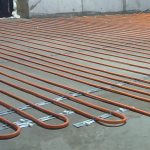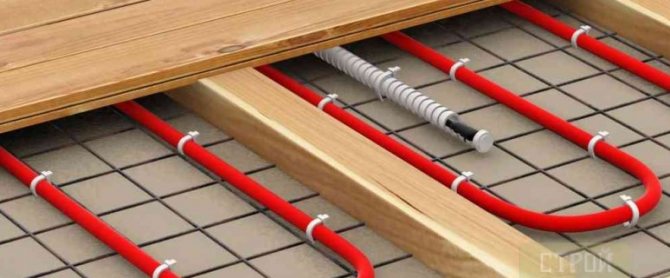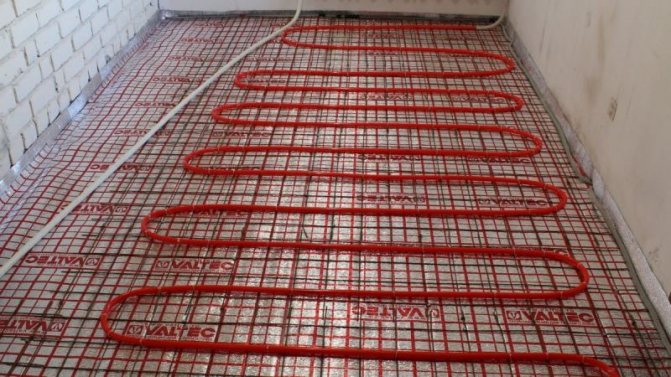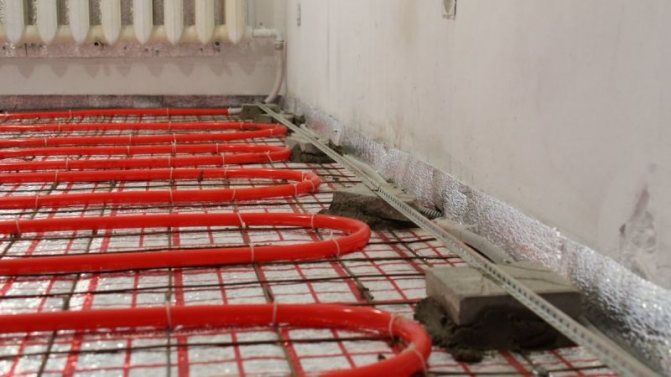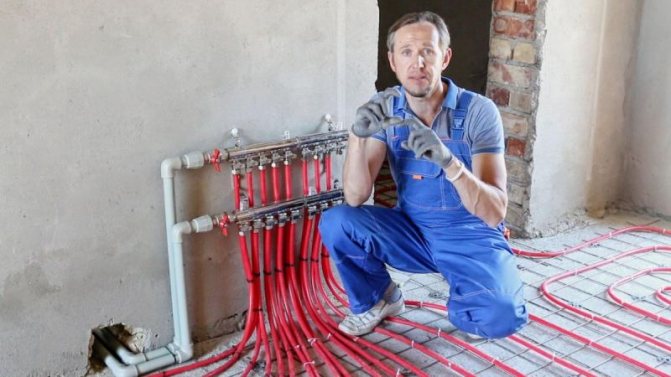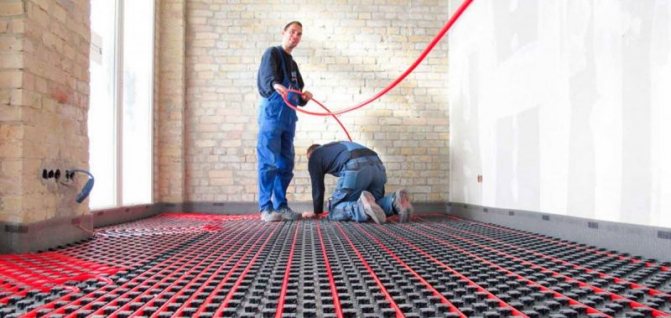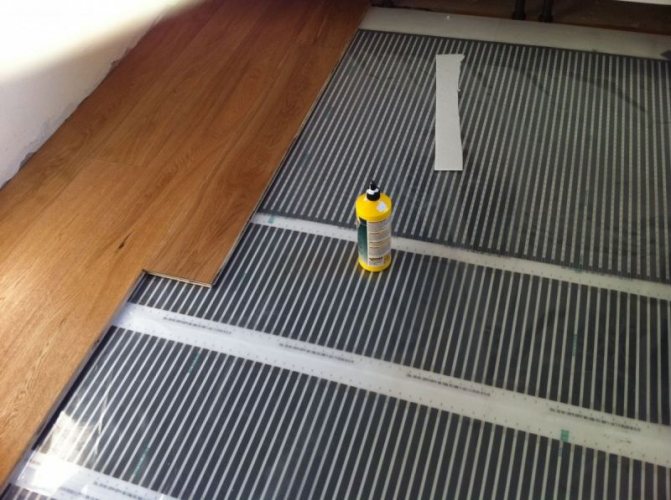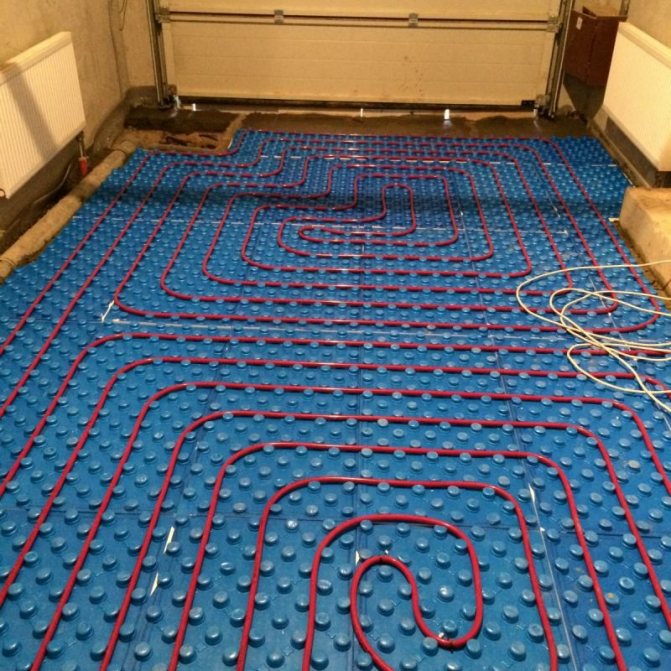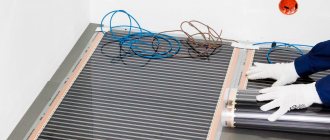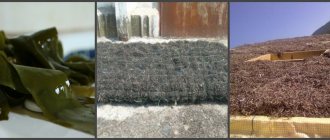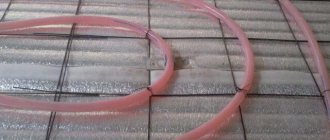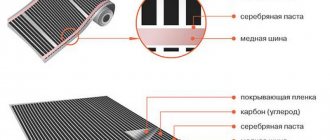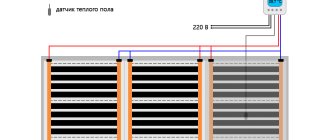Cable systems
The heating element here is a high-resistance conductor. Due to the high resistance, the core begins to warm up and give off heat to the floor. The most widespread is a two-core cable, the cores of which are connected at one end. The cable has external insulation and a metal braid (shield).
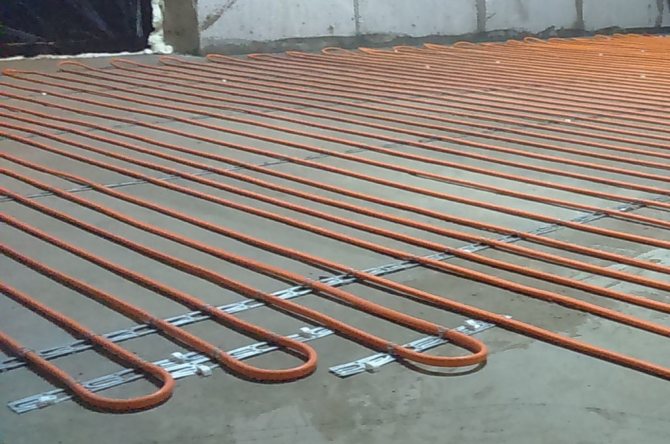
Installation is carried out using a metal tape with a zigzag conductor laying. Electricity and heating consumption largely depends on the step of laying the cable. On average, the power of a two-core cable is 110 - 150 W / m2, and an average of 7 running meters of cable are laid in 1 m2 of area.
The undoubted advantage of cable systems is their low price in comparison with other types of underfloor heating. So, for example, the Caleo Cable 18W-60, which costs 5800 rubles, is able to heat 8.3 m2 (the average size of the bathroom), while the heating mat will have to pay 30% more.
Which floors are better
We've looked at electric and infrared floor heating, and now is the time to determine which one is better?
Cable floors are best installed in bathrooms, nurseries or balconies because they offer better waterproofing than infrared. In addition, tiles, ceramics or screed can be placed on top of them.
Connections of infrared floor heating elements are very unreliable and quite often fail, while a cable electric floor is a solid cable. The only weak point in it is the clutch.
The price of a warm electric and infrared floor does not differ that much. Again, it all depends on the square of the room, the diameter of the cable and the cost of the services of the master.
Film infrared electric underfloor heating heats objects in the room, but not the air. Cable underfloor heating, like conventional batteries, heats up the cold air below, and then elementary physics goes - the air rises higher and higher as it heats up, and as a result you get a warm atmosphere under the ceiling, but not in your comfort zone.
Summing up, one could say that the score is a draw, but there is always some "But". Infrared floors would definitely outperform electric years in 5 years. The current level of production does not yet allow the full potential of this ingenious invention to be fully unleashed, but over time it will still become convenient, compact and one of the most optimal options for home heating.
__________________________________________________
Heating mat
The heating mat is the same two-core cable, only attached to a plastic mesh. On average, the cable pitch is 9 cm. The advantage of the heating mat is in the installation method: it is enough to roll it out over the useful area of the room and fill it with a screed or lay tiles.
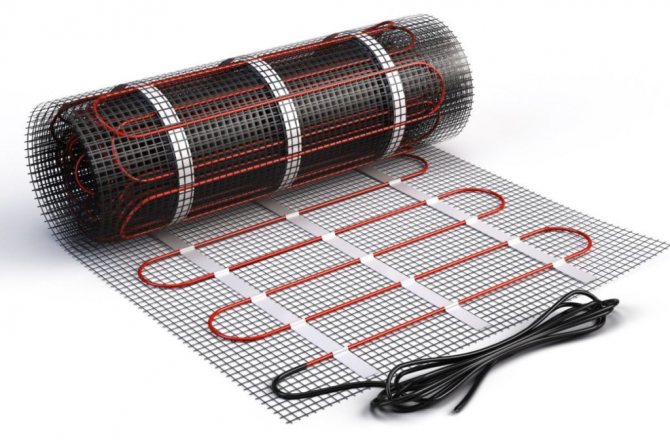

The power of the heating mats ranges from 130 to 150 W / m2, depending on the manufacturer. The maximum temperature to which the mat can be heated is 90 ° C. The cross-section of the conductors is 3.5 - 4 mm2. The ease of laying the mat is reflected in its price, which is significantly higher than that of a conventional cable. Here is a good heating mat STN Kvadrat heat KM-900-6.0 with a power of 150 W / m2.
Which floor heating to choose for a private house and apartment?
The selection of a floor heating system is carried out taking into account such factors as:
- the size of the room, in particular floor area and height;
- type of heating. Whether the underfloor heating system will be the main source of heating or an additional one will have a significant impact on its power.
Related article: Find the harmony of the color of the roof and the house
What to look for when choosing a warm floor
- indoor setting... All underfloor heating systems, except for the infrared rod, are very sensitive to overheating, which means that they cannot be mounted under furniture and heavy household appliances. The minimum height is 350 mm. This often leads to the fact that one part of the floor is significantly warmer than the other. Uneven heating (temperature changes) negatively affects the wooden flooring (floor board, solid board, parquet);
- wall height... It should be borne in mind that some underfloor heating systems are mounted exclusively in a screed. This statement is true for a water heated floor, rod and electric with a heating cable or mats. The higher the height of the heating element (pipe diameter or cable section), the thicker the screed will be. If the height of the walls does not allow raising the floor by 70-100 mm, then film warm floors should be considered;
- system maintainability... The screed completely blocks access to the system elements, which creates additional problems in the event of a malfunction, i.e. cannot be repaired quickly. Even identifying the place of failure without dismantling the floor is problematic;
- work speed... The speed of work is understood as the implementation of all types of work: from design to final surface finishing. Despite the fact that the core floor is installed within a few hours, it is not recommended to turn it on until the screed is completely dry, and some manufacturers (for example, Kaleo) set a limit of 28 days. The water floor is also mounted for a long time, which is associated with the specifics of the piping and also requires the complete solidification of the screed. The best option from the point of view of "operation immediately after installation" would be a film infrared heat-insulated floor.
- type of finish flooring... In many respects, the final choice is determined by the answer to the question, which warm floor is better for tiles, or which warm floor is better for laminate. Indeed, in one case, the use of glue is required, and not all systems are suitable for this, and in the other, it is necessary to take into account the tendency of wood to deform and the presence of harmful substances in the composition of materials (it is possible to release, for example, formaldehyde, when heated).
- profitability... Regarding which warm floor is more economical, users are unanimous and give the palm to rod floors for the economy of operation, and to water floors for the initial investment. But, is it always worth focusing on what is given cheaper? No, it is advisable to compare not by price, but to calculate the average costs for the operational period, and here infrared floors are in the lead.
As you can see, there are many factors that affect the final choice of a warm floor system, the fullest possible consideration of which will help to make the right choice.
IR film
The infrared film consists of a lower dielectric layer, carbon strips, which actually carry out heating, and an upper protective dielectric layer. The main advantage of the IR film is a small layer thickness, as well as low heating (up to a maximum of 50 ° C), so that it can be used for laying under decorative coatings without additional screed. For example, it can be placed under laminate, linoleum or even carpet.


However, the power of the film is 220 W / m2, which significantly increases energy consumption compared to other types of underfloor heating. Also, due to the low operating temperature, the stacking ratio over the usable area will be higher. We recommend using the film only as an additional source of heating. Here is a good inexpensive IR film from Q-TERM:
Film
Deciding which warm floor is better - infrared or cable, is impossible without careful consideration of the principle of operation of the infrared device. It is more complex in design than a solution with a wire, but it has certain advantages.The principle of heating the room here is that the heating element is not the only source of heat. It emits infrared waves, which, in turn, are capable of heating all objects in their path. Thus, all furnishings in the room will be potential heat sources. In addition, there are other advantages to this solution:
- Ease of installation - no screed is required, no additional structures on the floor and so on.
- High speed of reaching the heating mode - just a couple of minutes.
- Ease of configuring the heating circuit.
- The minimum thickness of all components of the structure.
- Light weight.
- High reliability of the device.
- Infrared radiation has beneficial effects on health, according to some medical professionals.
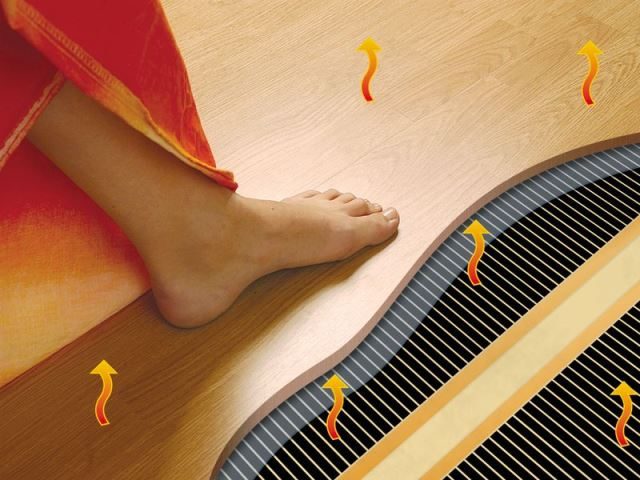

However, such devices have a lot of disadvantages. Some of them can become very critical when choosing:
- The need to lay an additional layer of insulating material when installing in a screed or a layer of tile adhesive.
- High energy consumption if the film is the main type of heating.
- It is not recommended to put heavy pieces of furniture on film parts.
- No heat accumulator in the form of a screed. Accordingly, after turning off the electricity, the room begins to cool down immediately.
- More complex installation than cable.
Despite the large number of disadvantages, in some cases, such devices can be an ideal solution. For example, if you need additional heating or temporary heating on a glassed-in balcony or loggia.
It is definitely impossible to decide which of the options presented in the material is better. They are quite effective and approximately equal in this indicator. However, some of the characteristics of the devices are different. Therefore, you should choose based on the tasks set - a wire is better suited for the main source of heat, and you can choose a film as additional heating. At the same time, the need to fill the screed is also important - if it is needed, then it is more advisable to choose a cable, and in case of its absence, you can opt for film devices.
Infrared carbon rods
IR bar floor is the evolution of cable and film systems. It is made in the form of a mat, only carbon infrared rods are used instead of a two-core wire. They emit infrared radiation that heats the floor. They are also mounted under a screed or glue. The operating temperature is almost the same as that of the film, about 60 ° C, but the power consumption is noticeably reduced and averages 120 - 160 W / m2.
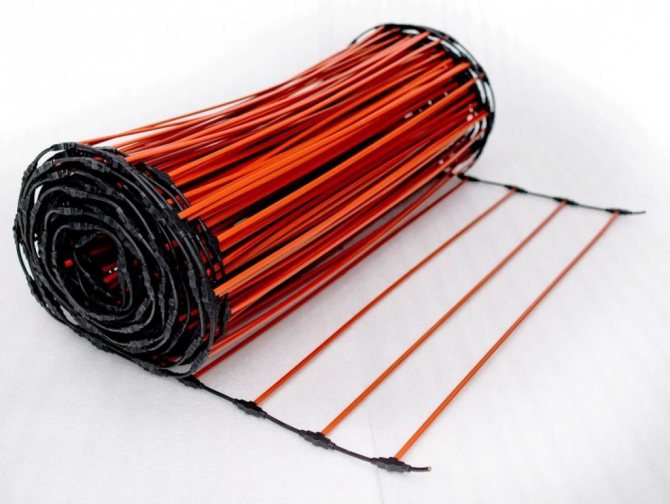

The core floor does not dry the air; you can safely put any furniture on it. Today it is the most expensive type of underfloor heating, and it is also used for the most part as an additional source of heating. For installation in a toilet, Unimat BOOST-0600 is suitable, which, with the total power of the heating elements, is capable of high-quality heating up to 4.98 m2 of usable area.
Which warm floor is better - species comparison
To simplify the comparison, you need to consider each type of floor and their distinctive features, advantages and disadvantages, and then compare the key indicators in a tabular form.
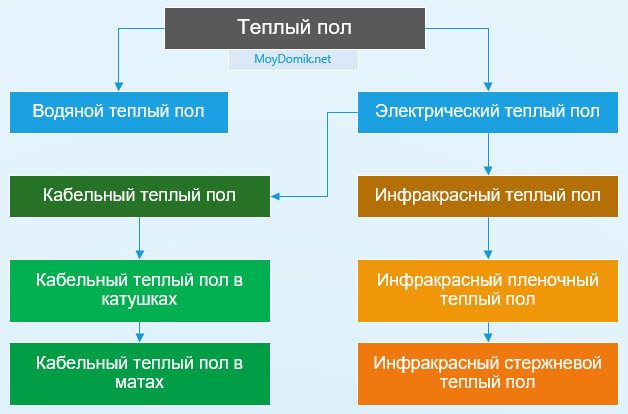

1 group - water heated floor
In this group, there is only one representative - a warm water floor, the heating element is a system of pipes through which a heat carrier (water) circulates.
Pros: reduction of heating costs by 25% (in comparison with radiator), minimal installation costs, the ability to equip autonomous heating or connect to a central system;
Cons: complexity of design and temperature control, high screed, low maintainability, risk of flooding, the need to approve the project when connected to the central heating main,the need to equip a boiler room and purchase additional equipment, high operating costs.
Group 2 - electric floor heating
This group is represented by several types of floors, so you need to evaluate which electric warm floor is better already in terms of subgroups.
Energy consumption calculation
The table below shows a comparison of the average for each heating system. For more accurate data, you should pay attention to the characteristics of the product from the manufacturer.
| TYPE TP | Heating element power, W / m2 | Working temperature, оС |
| Two-core cable | 150 | 90 |
| Heating mat | 150 | 90 |
| IR film | 220 | 50 |
| IR carbon rods | 140 | 60 |
The calculation of electricity consumption is carried out according to the following formula:
W = P * S * 0.6, where P is the total power of the heating system; S is the area of the room; 0.6 is the coefficient of usable area (the one that is not covered by furniture, carpets and other items) - for maximum accuracy, you need to draw a drawing of the room with a complete arrangement of furniture and mandatory indents from the walls of 30 cm.
So, the calculation of electricity consumption per hour, on an area of 10 m2 (we take conditionally) for each product (we take the average indicators from the table) will be as follows:
- Two-core cable - 150 * 10 * 0.6 = 0.9 kW / h
- Heating mat - 150 * 10 * 0.6 = 0.9 kWh
- IR film - 220 * 10 * 0.6 = 1.32 kWh
- IR carbon rods - 140 * 10 * 0.6 = 0.84 kWh
In this way, you can calculate the flow rate for each room. Then it is already necessary to multiply the result obtained by the operating time of the heated floor per day and we will get the exact amount that will have to be paid for the operation of the floor. But how long the warm floor will work per day already depends on the quality of the house insulation, heat loss and the level of room temperature that we want to get.
Roughly speaking, a warm floor working around the clock in a room of 10 m2 will cost you 120 rubles per day (one-rate tariff for Moscow).
In general, we can say that cable systems and a heating mat warm up the room the fastest (under the same installation conditions). However, they dry the air, reducing humidity, and are somewhat more difficult to install. In contrast, infrared emitters in the form of a film or rods are more gentle on the indoor climate, easier to install, but more expensive.
Most economical
When comparing a cable floor with an infrared floor, it is necessary to take into account the expected mode of operation of the systems:
- When switched on alternately, it will be much more profitable to install an IR film. It quickly heats up the room and does not waste energy on heating the thick layer of the screed.
- Constantly working infrared floors spend twice as much energy on maintaining a comfortable temperature as cable floors.
When using a warm floor as the only heating device in a room, it is economical to use cable floors, but if you only need to turn on auxiliary heating occasionally, then it is better to use IR foil.
Another indicator of the efficiency of the device is its strength and frequency of repairs. If the infrared floor plate is damaged, the system continues to function normally, and it will not be difficult to disassemble the floor for repair. If the cable is damaged, then the entire warm floor will stop working. For repairs, you will have to disassemble the floor, remove the screed and look for the place of damage.
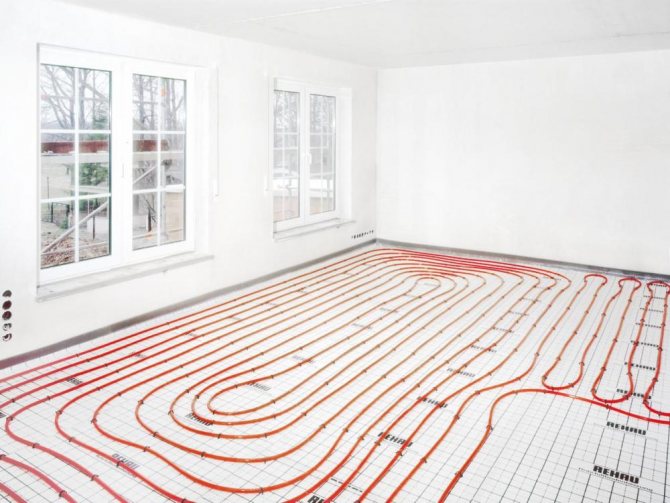

Saving methods with underfloor heating
If you are using (or just planning) underfloor heating as the main source of heating, then the following methods will save you money:
- Programmable thermostat... It can only be programmed to heat the floor during certain hours. On average, in winter, with good insulation of the apartment, the warm floor will work 8 - 10 hours a day. For example, you can set the system to work in this mode: 6:00 - 8:00, 16:00 - 22:00. Thus, the room will be warmed up before waking up and after coming from work.Of course, everyone sets the heating mode for themselves, depending on their work schedule and the need to maintain a certain temperature. You can use the Teplolux TP 515, an average-price thermostat, which is suitable for both electric and water floors.
- Multi-rate accounting electricity... We have already written about whether multi-tariff electricity metering is beneficial, which you can read about in the corresponding article. Here, we note that when connecting a multi-tariff meter, you can save money if you transfer the work of the heated floor to the night zone (23:00 - 7:00) or half-peak (10:00 - 17:00, 21:00 - 23:00). If the underfloor heating works exclusively at night, then the energy savings will be up to 55%. And provided that this system is the main source of heating, then the savings will be very significant.
If you know how else you can save money with a warm floor, share it in the comments!
Varieties of electric underfloor heating
You can distinguish the following list of varieties of electric warm floors:
- cable;
- film;
- rod;
- liquid.
In order to understand which warm floor is better to choose from the specified list, you should understand in detail all types.
It is worth starting the review with cable systems, since they have been on the market for the longest time. Such a system functions according to a similar principle to water-heated floors, with the only difference being that the heat carrier acts as a heat carrier, and not pipes. After installation, the heating system is filled with cement screed and covered with a fine floor covering.
After the temperature is set on the thermostat, the entire floor surface heats up to the specified indicators. The thermostat regulates the temperature according to the readings from the temperature sensor installed in the floor.
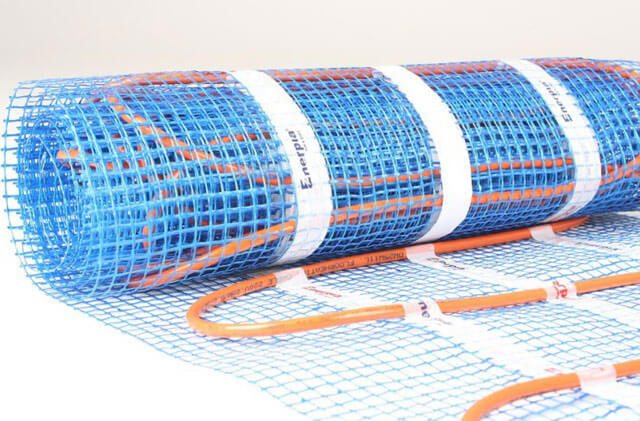

On the market you can find another type of heating system designed specifically for tiles - heating mats. They are intended for laying under a thin layer of mortar or glue. The mats consist of a mesh, on which heat cables are placed at some intervals. Such material is produced in rolls - for laying, you just need to roll it out on the floor. The buyer is presented with the opportunity to choose heating elements with different heat output, based on their needs.
Another type of underfloor heating - film floor - which one to choose in this case, we will tell you below. The thickness of the heater in it is usually less than 3 mm, with a roll width of 500-1000 mm. The film is produced with different heat transfer rates. This type of heating element is designed specifically for installation under any floor covering without a screed, except perhaps for tiles.
If we talk about what is better, a film or cable heat-insulated floor, then we can answer that the first option, since the manufacturer notes that in this case the heating element radiates the most favorable long-wave soft heat for a person.
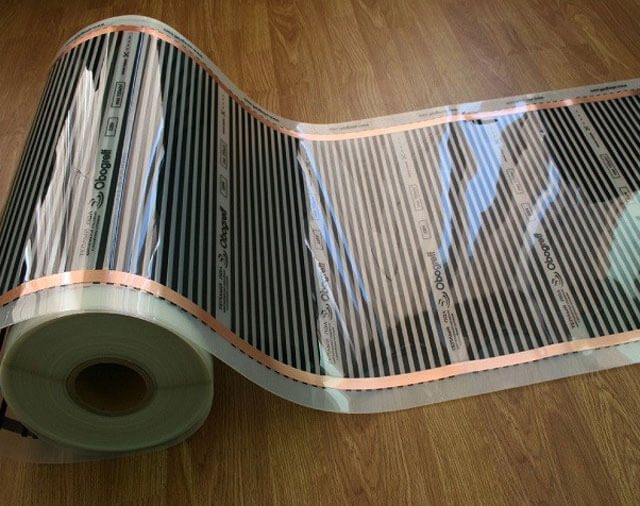

Rod underfloor heating represents corner heaters connected by conductors and forming a mesh, collected in a roll. All carbon rods are independent, which means that if one of the elements stops functioning, then it will not be necessary to open the screed, since the remaining sections will continue to heat the floor. This type of underfloor heating can be installed under a screed in any type of living space.
The list of floor heating types will be completed by a hybrid system that combines electric and water heating. In PE pipes with a heat-conducting liquid, a heating nichrome insulated core is placed. On one side of such a cable there is a connecting sleeve, and on the other side there is a damper designed to compensate for the liquid expanding in volume in a closed loop.
When installing this type of heating system, the same approaches are used as when laying water-heated floors. The only difference is the type of connection, which is carried out to the mains through the temperature controller.
